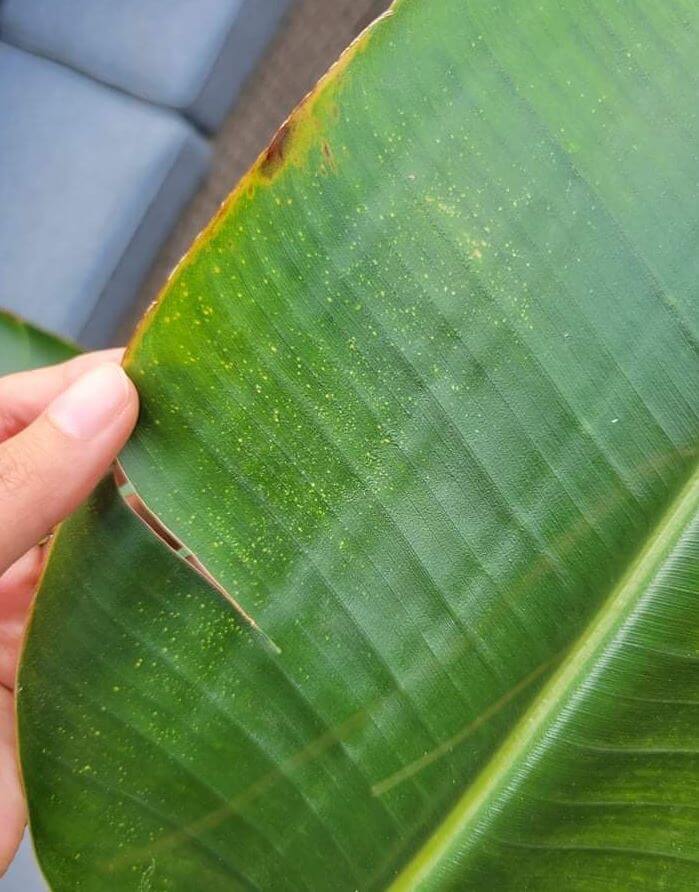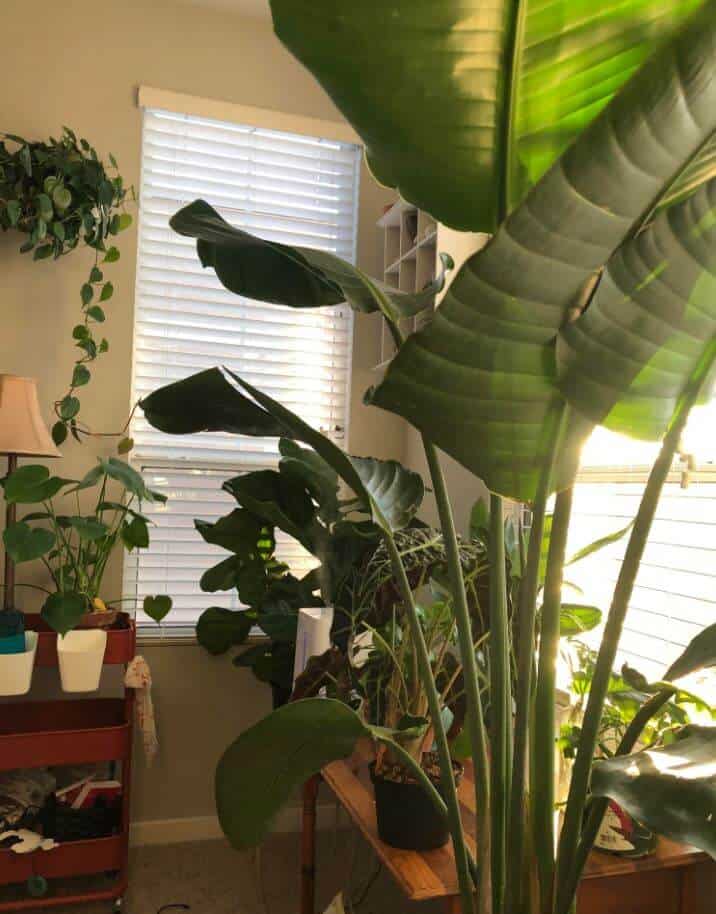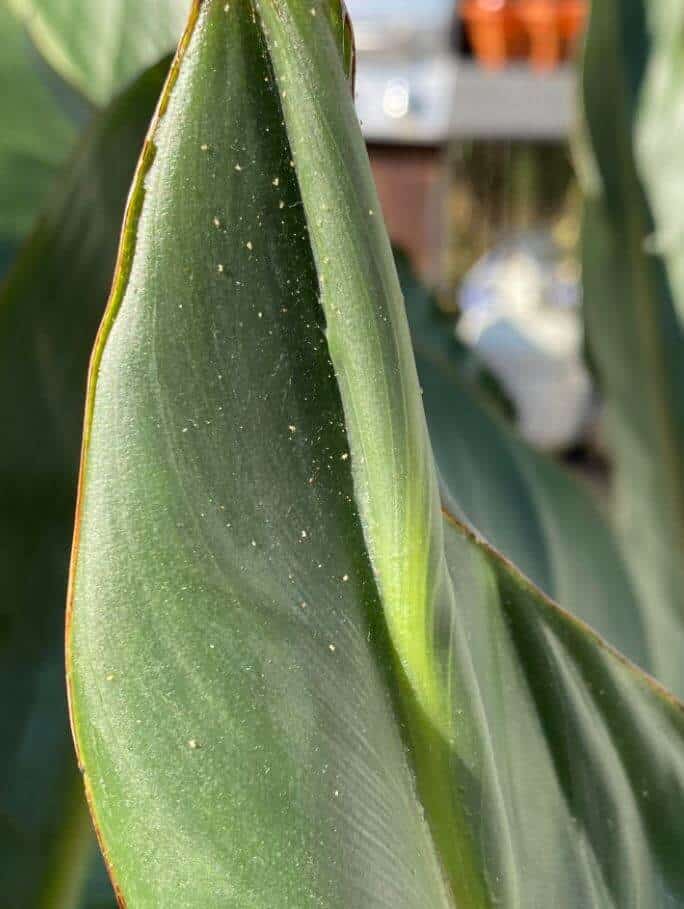Last Updated on October 3, 2023 by a Friendly Gardener
The Bird of Paradise plant, botanically known as the Strelitzia reginae, is not generally at risk for severe pest infestation. However, they can occasionally attract scale insects, mealybugs, and spider mites.
When pests take up residence on your Bird of Paradise plant, they can be incredibly destructive, so immediate intervention is essential to limit potential plant damage. Spider mites are tiny insects that are sap suckers, so they can quickly wreak havoc on your plant. Members of the Tetranychidae are very common to the North American continent and can be found on indoor and outdoor plants. When left unattended, they can place your plant’s survival at risk.
The first sign of spider mites on Bird of Paradise plants will usually be webbing on the undersides of leaves. They live in colonies and will feed on your Bird of Paradise plant by piercing leaf tissue and sucking its sap. Light dots may appear on the leaf surface as they feed on foliage, draining it of nutrients. As the damage progresses, leaves often turn yellow, die, and fall off.
Spider Mites

Not really insects, the spider mite is an arachnid, so they are related to ticks, spiders, and scorpions. Either pale or reddish-brown tint, these pests have an oval shape and are no more significant than the size of a period on a printed page, approximately 1/50 inch in length. Juvenile spider mites resemble adults by they are even tinier.
The mites are widespread pests in outdoor gardens, but their petite size makes them challenging to spot with the naked eye. They possess eight legs as opposed to six and, for this reason, are classified as arachnids related to spiders. Most spider mite species can produce very fine silk webs.
The spider mite category has more than 1600 various species. The more common North American spider mites are the red spider mite and the two-spotted spider mite. Color variations include orange, red, yellow, green, and brown. The primary spider mite on houseplants is the Tetranychus Urticae or two-spotted spider mites.
The Spider Mite Life Cycle

Many spider mite species overwinter in the egg form. They can be found on foliage and stems or barks. When spring arrives, the temperatures rise, and six-legged larvae emerge from hatching eggs. They feed for several days and then shelter to molt into eight-legged nymphs. They molt a total of three times before maturing into adulthood.
When adult spider mites mate, they can produce up to 300 eggs in the immediate weeks following the mating ritual, resulting in several generations living together in one year.
Environmental Conditions Conducive to Spider Mite Infestations
Spider mites love dry, hot conditions. In nature, some predators feed on spider mites, aiding in pest control. If natural predators are eliminated using pesticides, spider mite proliferation is favored. These mites are very prolific and reproduce in large numbers rapidly. These creatures are so tiny they often go unnoticed until the infestation is so severe that plant damage is apparent unless webbing is noticeable on plant parts.
Bird of Paradise Plant Spider Mite Damage and Detection

Although the naked eye cannot see spider mites, the damage is most certainly noticeable. They can kill ornamental plants such as the Bird of Paradise as mite populations grow uncontrollably.
Examine your plant every few days using a 10X magnifying lens for yellow or white spots. If you notice spots, check the leaf underside for telltale signs of webbing. If you do not have a lens, place a sheet of white paper underneath the foliage and tap it. If spider mites are present, they should fall onto the paper.
If you discover spider mites on your plant, isolate them immediately, as spider mites spread quickly to other houseplants. If you find them on a Bird of Paradise in your outdoor garden, you need to intervene directly to protect your garden. It is improbable that a severely infested plant can recover, so it must be disposed of but not added to the compost bin.
Eliminating Spider Mites from Bird of Paradise Plants

Spider mites have a talent for developing a resistance to numerous pesticides. Pesticides also eliminate beneficial predator insects that feed on the mites. Organic methods are more effective in removing and controlling these pests. To eliminate pests and protect your plant:
-
Prune your Bird of Paradise plant
Infested parts of the plant need to be trimmed off and webbing removed. If you are cultivating more than one plant in an outdoor garden, do not hesitate to remove entire plants if they are infested.
-
Water plants regularly
Spider mites thrive in dry environments, and plants stressed by underwatering are more susceptible to an infestation.
-
Wash your plant
Showering or washing your plant with a jet water spray will eliminate spider mites and reduce the population. Collected dust on foliage and plant parts encourages spider mite infestation.
-
Introduce beneficial predator pests
Ladybugs, predatory mites, and Lacewings are available commercially. These insects feed on spider mites.
-
Organic neem oil
Organic neem oil will kill pest eggs. A horticultural oil should be applied every 3 to 5 days to interrupt the spider mite reproductive cycle fully. All plant parts should be treated, including the undersides of foliage. Do not apply oils if temperatures exceed 90°F. Insecticidal soaps can also be used.
A Final Thought

While the Bird of Paradise plant is generally not prone to pest infestations, it can attract spider mites. Treat your plant at the first sign and repeat treatment weekly for several weeks. Also, wipe down the plant often to remove dust.

